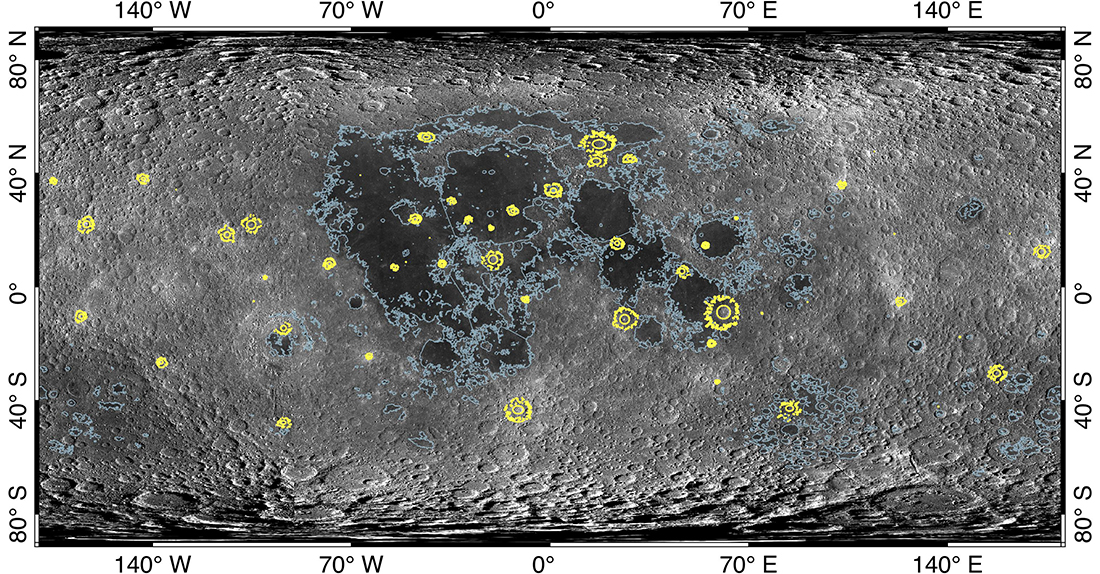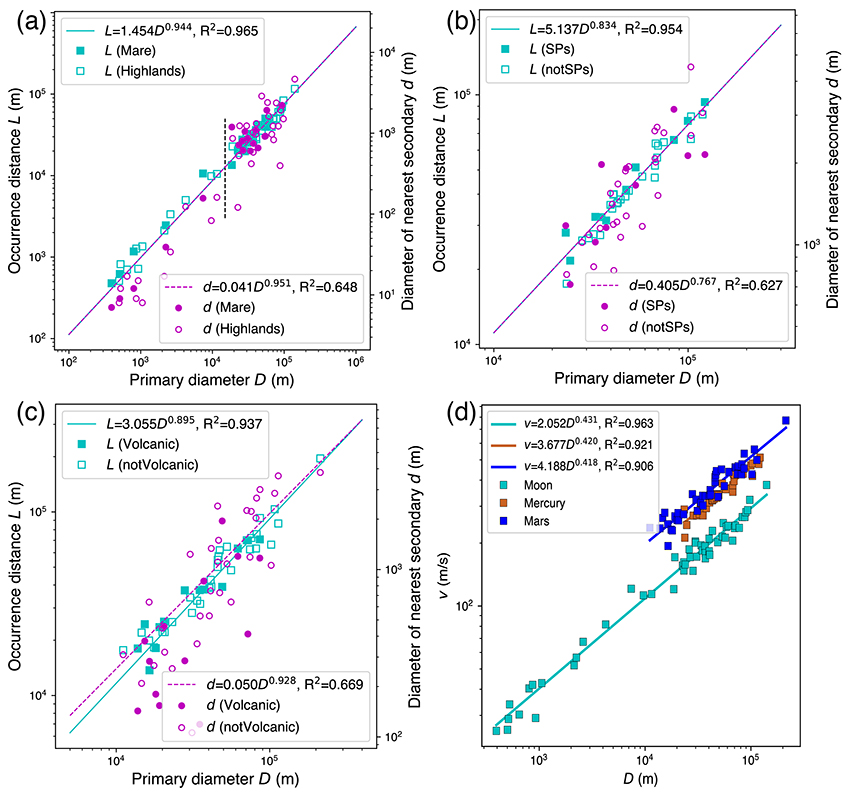Minimum velocity of forming secondary craters on terrestrial bodies
- 1Planetary Environmental and Astrobiological Research Laboratory, Sun Yat-sen University, Zhuhai, China
- 2CAS Center for Excellence in Comparative Planetology, Hefei, China
Introduction: The determination of the minimum velocity (v) required for impact ejecta to form secondary craters (secondaries) constitutes a pivotal parameter in elucidating various aspects of impact dynamics, including the extent of mixing between primary ejecta and secondary-excavated local materials, the volumetric proportions of primary ejecta capable of forming secondaries, etc. Nonetheless, there exists a notable scarcity of information regarding this parameter. Typical secondaries formed on terrestrial bodies exhibit distinctive morphologies (e.g., herringbone-shaped tertiary ejecta) consistent with clustered impact origin [1–3]. Modelling impacts of clustered fragments in porous target recorded formation of craters at velocities as low as ~20 m/s [4]. However, the application of v derived from laboratory simulations to terrestrial bodies is not straightforward due to that the cratering efficiency of low-velocity impacts is strongly correlated to surface gravities and target properties. Considering the influence of actual planetary surface conditions on the formation of secondaries, investigations into the diameter-range distribution of continuous chains of secondaries have been employed to deduce the size-velocity distribution of impact ejecta that are capable to form secondaries [5–7]. These works suggest that secondaries can originate from ejecta with velocities as low as ~50 m/s on the Moon [6], ~200 m/s on Mars [5], and ~300 m/s on Mercury [7]. However, comprehensive observations of secondaries occured nearest to the rims of their parent craters are not conducted yet on either the Moon or terrestrial bodies.

Fig. 1. Mapping example of nearest secondaries (yellow dots) on the Moon. Grey polygons outline the lunar mare regions [8].
Methods: In this work, using regional and global optical images and topographical data, we conduct a systematic mapping (53 craters with rim-to-rim diameter D=0.4–140 km on the Moon, 35 craters with D=23–122 km on Mercury and 43 craters with D=11–213 km on Mars) of the nearest secondaries surrounding relatively young primary craters that have diverse diameter sizes and target properties on the Moon, Mercury, and Mars (e.g., Fig. 1). Through comprehensive documentation of radial occurrence distances (L) and rim-to-rim diameters (d) pertaining to nearest secondaries, we derive estimations for the minimum v under ballistic flight and corresponding equivalent sizes of ejecta requisite for the formation of secondaries.
Preliminary Results: We found that in the vicinity of young craters with similar rim-to-rim diameters on terrestrial bodies, the radial occurrence distances (L) and rim-to-rim diameters (d) of the nearest secondaries are statistically comparable, irrespective of the target properties and the surface gravities (Fig. 2a–c), with the exception of smaller secondaries on Mars, where high-dispersion effect of water/ice on ejecta fragments may account for such variation. Ejecta with velocities exceeding ~25 m/s are capable of forming secondaries around craters with diameters less than 0.5 km, with surface gravity identified as the principal determinant (Fig. 2d). Nevertheless, encircling larger primary craters, ejecta launched at higher velocities constitute continuous ejecta deposits, indicating that potential secondaries are not preserved due to destruction by subsequent landing ejecta. These relationships (L vs. D, d vs. D and v vs. D) can function as predictive tools for determining the positions of possible nearest secondaries on Earth and Venus, and offering valuable insights into the formation conditions of self-secondaries and tertiary craters.

Fig. 2. Locations and sizes of the nearest secondaries around young craters with different target properties (i.e., lunar mare/highlands, mercurian smooth plains (SPs)/not SPs, Martian volcanic units/not volcanic units) on the Moon (a), Mercury (b), Mars (c), and the minimum secondary-forming velocities on these bodies (d).
Acknowledgments: This research is supported by the National Natural Science Foundation of China (423B2205; 42241108; 42273040; 62227901), the Strategic Priority Research Program of Chinese Academy of Science (XDB41000000) and China Scholarship Council (202306380194).
References:
[1] Oberbeck, V. R. & Morrison, R. H. Laboratory simulation of the herringbone pattern associated with lunar secondary crater chains. The Moon 9(3–4), 415–455 (1974).
[2] Xiao, Z. Size-frequency distribution of different secondary crater populations: 1. Equilibrium caused by secondary impacts: equilibrium caused by secondaries. J. Geophys. Res. Planets 121, 2404–2425 (2016).
[3] Xu, R., Xiao, Z., Luo, F., Wang, Y. & Cui, J. Untrackable distal ejecta on planetary surfaces. Nature Communications 14(1), 1173 (2023).
[4] Schultz, P. H. & Gault, D. E. Clustered impacts: Experiments and implications. J. Geophys. Res. 90, 3701–3732 (1985).
[5] Vickery, A. M. Size-velocity distribution of large ejecta fragments. Icarus 67, 224–236 (1986).
[6] Singer, K. N., Jolliff, B. L. & McKinnon, W. B. Lunar Secondary Craters and Estimated Ejecta Block Sizes Reveal a Scale‐Dependent Fragmentation Trend. JGR Planets 125, e2019JE006313 (2020).
[7] Xiao, Z. et al. Comparisons of fresh complex impact craters on Mercury and the Moon: Implications for controlling factors in impact excavation processes. Icarus 228, 260–275 (2014).
[8] Hiesinger, H., Head, J. W., Wolf, U., Jaumann, R. & Neukum, G. Ages and stratigraphy of lunar mare basalts: A synthesis. Recent advances and current research issues in lunar stratigraphy 477, 1–51 (2011).
How to cite: Xu, R., Xiao, Z., Wang, Y., Luo, F., and Ma, Y.: Minimum velocity of forming secondary craters on terrestrial bodies, Europlanet Science Congress 2024, Berlin, Germany, 8–13 Sep 2024, EPSC2024-477, https://doi.org/10.5194/epsc2024-477, 2024.